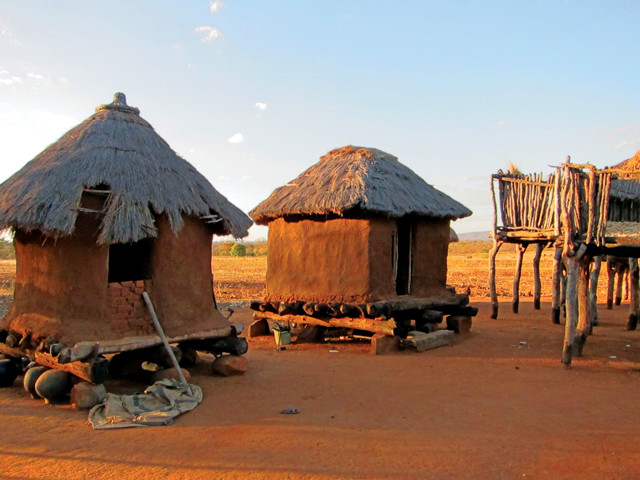
by Mary Caperton Morton Monday, December 14, 2015

Grain bins, such as these modern examples in South Africa, were burned in drought rituals during the Iron Age in Africa. The scorched earth beneath the structures has preserved rare clues about Earth's magnetic field 1,000 years ago. Credit: John Tarduno/University of Rochester.
Throughout Earth’s history, the planet’s magnetic field has changed polarity hundreds of times, with the magnetic north and south poles swapping positions. These reversals sometimes occur every few thousand years, or after hundreds of thousands of years. The last known magnetic reversal took place nearly 800,000 years ago, leaving many to wonder if we’re overdue for a reversal. Now, research from southern Africa, an understudied region, analyzing magnetized minerals preserved in the charred floors of 1,000-year-old torched huts has shed light on geomagnetic patterns that may indicate — or perhaps even trigger — such a switch.
“The Southern Hemisphere is a big player in understanding Earth’s magnetic field, but obtaining data has been difficult,” says John Tarduno, a geophysicist at the University of Rochester and lead author of the new study, published in Nature Communications. Studies of Earth’s recent magnetic field have mostly relied on archaeomagnetic data, largely from fired ceramics, which contain magnetic minerals that record information about Earth’s magnetic field as they cool.
But even though magnetic data from ceramic pot shards are useful in establishing the strength of the magnetic field at the time of firing, the orientation of the field is impossible to detect from objects after they’ve been moved, Tarduno says.
So he and his colleagues turned to a different archaeological source: the charred floors of intentionally burned huts up to 1,000 years old in the Limpopo River Valley on the borders between present-day South Africa, Zimbabwe and Botswana. “Many of the structures were made of clay, and when you burn clay it stabilizes the magnetic mineralogy,” Tarduno says. “By having this type of material we can potentially derive both measurements: strength and orientation.”
“In times of drought, people in these villages believed they needed to partake in ritualistic cleansings that involved the burning down of villages,” Tarduno says. Using the remains of huts, dated to between 1013 and 1585, his team reported in Nature Communications that they were able to record nearly 600 years of magnetic field changes.
The floors recorded a series of rapid changes in Earth’s magnetic field that took place between 1225 and 1550. “This period around 1300, where Earth’s magnetic field showed very rapid changes and dropped to low field values, is very similar to what’s happening today in this region,” Tarduno says. “This weakening of the magnetic field, which has been very well documented over the last 160 years by magnetic observatories and satellites, is thought to be due to a feature on the core-mantle boundary where the field is actually already reversed.”
This feature is known as the large low-shear-velocity province because of its distinctively slow seismic signature, which may indicate large-scale thermal or chemical composition anomalies on the boundary between the mantle and the core. This anomaly may create what’s called a reverse flux patch where the magnetic field is reversed. Over time, this localized reversal may disappear, or it could grow and possibly trigger a global magnetic reversal, the researchers noted.
“The flux patch we detected at 1300 eventually decayed away, but eventually one of these things may grow large enough to trigger a reversal,” Tarduno says. “Previously, people have thought that reversals can nucleate anywhere on the core-mantle boundary, but we think it may occur at one of these flux patches.”
Indeed, “this study suggests that there are locations where particular field configurations might recur throughout geologic time that could stimulate or initiate a reversal at a specific geographic location,” says Catherine Constable, a geophysicist at the University of California at San Diego, who was not involved in the new research. “This is not a new idea, but this study presents some of the first data we’ve seen from the Southern Hemisphere in support of the hypothesis.”
The next step will be to extend the geomagnetic record for southern Africa back even further. “We reported on a 600-year time span, and we think we can go back another 600 [years],” Tarduno says.
The work adds important data in the effort to create a global geomagnetic dataset, Constable says. “If they can get a longer time series and integrate those data into a global picture of what the field has been doing, that would be fantastic,” she says. “The Southern Hemisphere has been so under-sampled; it’s really time to fill in the missing data.”
© 2008-2021. All rights reserved. Any copying, redistribution or retransmission of any of the contents of this service without the expressed written permission of the American Geosciences Institute is expressly prohibited. Click here for all copyright requests.